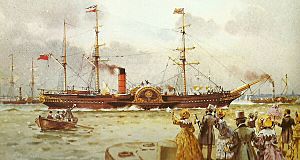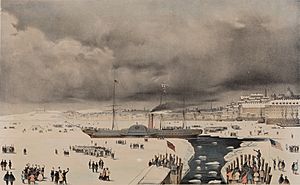RMS Britannia facts for kids

RMS Britannia at harbour.
|
|
Quick facts for kids History |
|
|---|---|
| Name | RMS Britannia |
| Namesake | Britannia |
| Owner | British and North American Royal Mail Steam Packet Company |
| Builder | Robert Duncan & Company, Greenock, Scotland |
| Launched | 5 February 1840 |
| Maiden voyage | 4 July 1840 |
| Out of service | Sold to the Reichsflotte in March 1849 |
| Name | SMS Barbarossa |
| Acquired | March 1849 |
| Out of service | Transferred to the Prussian Navy in June 1852 |
| Name | SMS Barbarossa |
| Acquired | June 1852 |
| Fate | Sunk as a target ship in July 1880 |
| General characteristics | |
| Class and type | Britannia-class steamship |
| Tons burthen | 1,154 |
| Length | 207 ft (63 m) |
| Beam | 34 ft (10 m) |
| Draught | 16.8 ft (5.1 m) |
| Propulsion |
|
| Speed | 8.5 knots (15.7 km/h) |
| Range | 640 tons coal |
| Capacity | 115 passengers |
| Crew | 82 |
The RMS Britannia was a famous ocean liner. It belonged to the British and North American Royal Mail Steam Packet Company. This company later became known as the Cunard Steamship Company. The Britannia was built in Greenock, Scotland, and launched on February 5, 1840.
She was one of the first four ocean liners built by the company. Her sister ships were the Acadia, Caledonia, and Columbia. These ships were very important for travel across the Atlantic Ocean.
Contents
About the Ship and Its Journeys
The Britannia was a large ship for its time. It was 207 feet (63 meters) long and 34 feet (10.3 meters) wide. The ship had a wooden hull and three masts. It moved using big paddle wheels on its sides. These wheels were powered by a steam engine. The engine used coal and had about 740 horsepower.
Speed and Capacity
The ship was quite fast for the 1840s. It usually traveled at about 8.5 knots (15.7 km/h). If the winds and currents were helpful, it could go even faster. The Britannia could carry 115 passengers and had a crew of 82 people. It also had space for 1,154 tons of cargo.
First Voyage and Cargo
The Britannia's first trip started on July 4, 1840. It sailed from Liverpool, England, to Halifax, Nova Scotia. This journey took 12 days and 10 hours. After Halifax, it continued to Boston, Massachusetts.
The ship carried many different things. This included 600 tons of coal to power the engine. It also carried mail, livestock for food, and even cats to catch rats!
Setting a New Record
On its first trip back from Halifax to Liverpool, the Britannia was very fast. It completed the journey in just under 10 days. It traveled at an average speed of about 11 knots (20 km/h). This set a new record for the fastest eastbound crossing of the Atlantic. This record stood until 1842.
Life Onboard
The Britannia and its sister ships could carry 115 passengers and 225 tons of cargo. The main dining room was a long building on the top deck. There was also a special room just for ladies. Traveling on the Britannia was quite expensive. The ticket price included food and drinks like wine.
A Famous Passenger
In January 1842, the famous writer Charles Dickens and his wife traveled on the Britannia. They were going to the United States. Dickens found the journey very rough. He was seasick for most of the trip. He decided to return home on a sailing ship instead!
As SMS Barbarossa in German Service
In March 1849, the Cunard company sold the Britannia. It was bought by the German Confederation. The ship was renamed SMS Barbarossa. It was fitted with nine guns and became a warship.
Flagship and Target
The Barbarossa became the main ship of the German fleet, called the Reichsflotte. It fought in the Battle of Heligoland. In June 1852, the ship was given to the Prussian Navy. It was then used as a barracks ship, a floating home for sailors, in Danzig. In May 1880, the Prussian Navy stopped using it. In July 1880, the SMS Barbarossa was sunk. It was used as a target ship for practice.
Britannia in Film
The story of how the Britannia was funded and made its first trip was shown in a movie. This film was released in 1941. It was called Atlantic Ferry in the UK and Sons of the Sea in the US.


